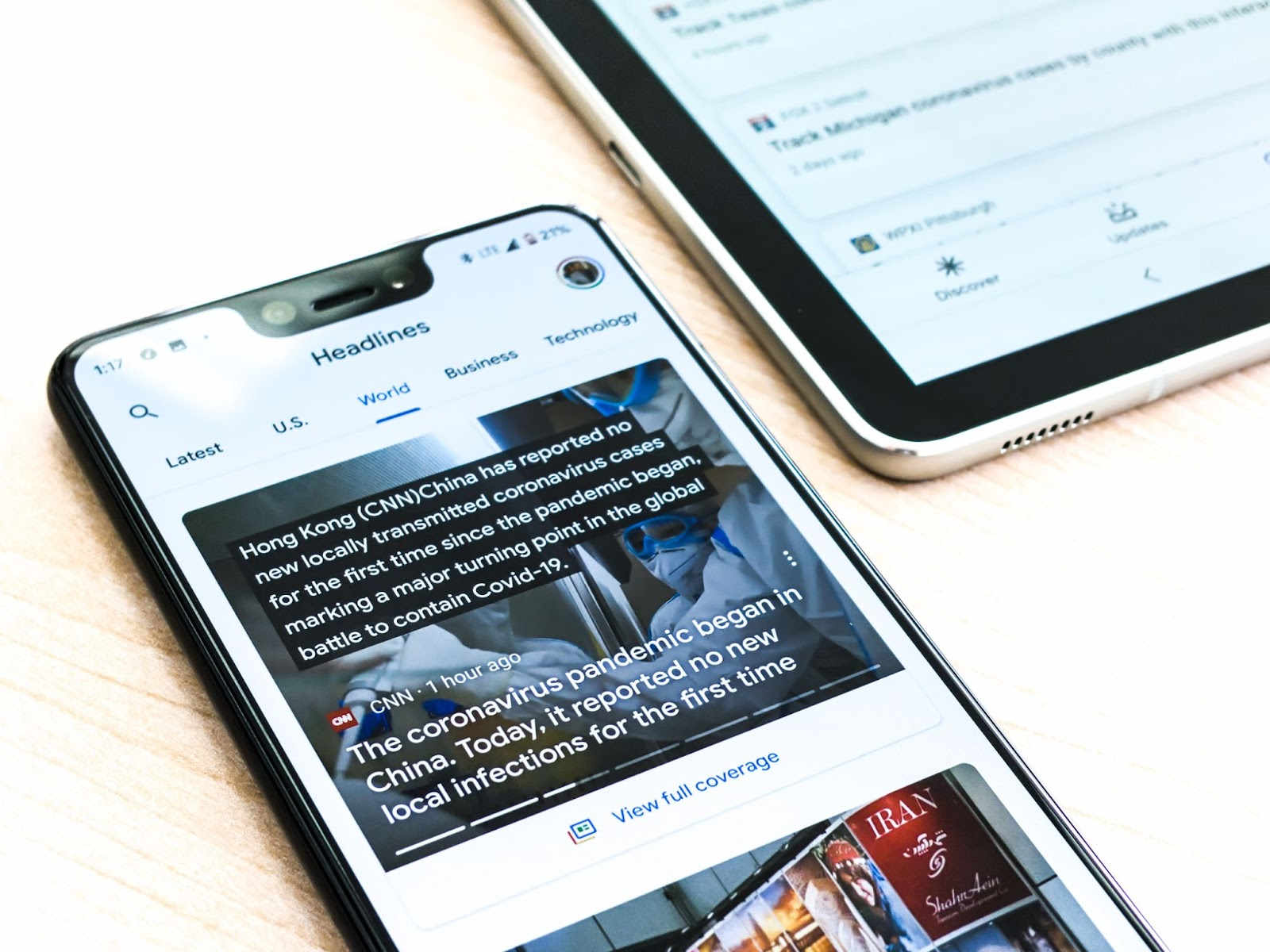In the United States, roughly 86% of adults say they get at least some of their news online via smartphone, computer or tablet. By contrast, 68% of adults say they receive news via television, while only 32% read print sources. With online media dominating the news cycle, journalists must find new ways to ensure their work is accessible and impactful.
Fortunately, there are ways that newsrooms can begin to focus on the production of accessible online audio and video content. Resources like transcription tools for journalists will be critical for broadening their reach and promoting more effective communications with audiences and teams.
Table of Contents:
- What is Journalism Transcription?
- How Can Journalists Benefit from Transcription?
- Do Journalists Transcribe Interviews?
- How Do Journalists Transcribe Interviews?
What is Journalism Transcription?
Generally speaking, transcription generates a written record of spoken text from audio or video content. Transcripts are a common way of supporting individuals with disabilities or learning differences, but they can also be extremely valuable tools for record-keeping. In a journalistic setting, there’s certainly no shortage of possible uses for transcription.
When it comes to transcription production, there are a few different options. Some companies use in-house employees to review audio and video recordings and manually transcribe the content word-for-word. While seemingly cost-effective, assigning the task of transcribing to employees without specific training is often problematic. Completing these transcripts tends to be unduly time-consuming while also leading to some major accuracy issues. If these transcripts have a significant number of mistakes, someone will then need to review and edit them by hand, causing further inefficiencies. Additionally, transcription errors can be embarrassing and even offensive so neglecting that review stage isn’t a great time-saving option.
Some companies hire professional human transcribers to reduce the risks of errors and allow employees to allocate their time better. These individuals are experts who can create highly accurate final products. However, such services can be costly. It can also be difficult for human transcribers to produce a high transcripts volume quickly. These bandwidth issues are a setback to companies that need to scale their transcription efforts.
As a result, many media professionals looking for fast, accurate and cost-effective transcription solutions turn to transcription services like Verbit. Verbit’s transcription software for journalists uses Artificial Intelligence to produce initial transcripts that a vast network of human transcribers then review and edit. As a result, Verbit can generate transcripts with high accuracy in as little as four hours.
It’s important to note that some media platforms like YouTube and Vimeo offer automatic transcription tools for journalists. However, these transcripts tend to miss the mark on accuracy. In fact, research indicates that the accuracy rate of auto-generated captions and transcripts can drop to as low as 50%. This level of inaccuracy is inconsistent with the requirements of both the ADA and the FCC. Fortunately, there are other transcription services for journalists that can better meet the industry’s specific needs.

How Can Journalists Benefit from Transcription?
It’s clear that journalists can support their work through transcription. Here is a clear breakdown of three of the major benefits of this resource.
Transcription Boosts Efficiency
Creating and maintaining written records of essential communications can save journalists one of their most valuable resources — time. Transcription eliminates the need for meticulous note-taking in meetings and interviews. It also cuts back on time spent flipping through old stories or rewinding long bits of footage in search of specific information.
Transcription Improves Accessibility
Providing transcripts of audio and video content helps to ensure equitable access to information. Transcribing internal communications can support the needs of employees with disabilities or specific learning needs. In the case of external communications like online videos or podcasts, transcripts can offer more inclusive experiences to audience members who require accommodations to engage with the content meaningfully.
Transcription Grows Your Audience
Offering written transcripts can expand the reach of content to new markets. Transcription is a valuable tool for individuals who consume content in a non-native language, for example. Digital media in particular, benefits from transcription because a significant portion of the population chooses to view online videos with the sound off. Online transcripts will also allow search engines to “crawl” the content. This step can improve web discoverability and increase a network’s SEO ranking.
What Are Some Possible Uses for Transcription?
Currently, there is a broad spectrum of available transcription help for journalists. Let’s explore some of the transcription tools for digital newsrooms and their possible applications.
Call transcription
Transcription solutions can provide accurate records of two-way calls, conference calls, Zoom chats and more. Having written accounts of both internal and external calls can help to ensure the information in those communications is documented properly for future reference. Call transcription is a particularly valuable tool for individuals who are working remotely. Also, some people simply prefer to engage with information in a readable format. Providing written transcripts can support more accurate messaging and safeguard against issues posed by poor audio quality or prominent background noise.
Meeting transcription
Similarly, transcribing recordings of meetings — whether in person or online — can provide more accurate accounts of conversations both live and after the fact. Making these transcripts available to participants can eliminate the need for attendees to take meticulous notes, thus improving real-time engagement. Transcripts can also help anyone unable to attend the live meeting to catch up, ensuring consistent messaging. Verbit offers live transcription for meetings on platforms like Zoom. Verbit provides tools like board meeting transcription to support effective communication, even when attendees are tuning in from different locations or time zones. These transcripts are also fully searchable, making it easy for participants to navigate to specific points in a conversation.
Podcast transcription
In recent years, podcasting has emerged as a popular platform for content in various genres. Many individuals who previously turned to the radio for their news briefings now rely on podcasts to stay up to date. A trusted transcription service for journalists makes it easy for podcast creators to transcribe audio to text and offer readable versions of the content they work so hard to produce. While roughly 30% of Americans say they regularly listen to podcasts, the medium is not generally inclusive of consumers who are Deaf or hard of hearing and those with auditory processing disorders. Written transcripts can help media producers expand their audience to include those who otherwise would be unable to engage with audio-only content.
Focus group transcription
Focus groups are a trusted tool for journalists and media companies looking to get the public’s perspective on specific issues or current events. By transcribing the discussions that take place during these focus groups, producers can maintain accurate records of all of the information participants share. This process can reduce the risk of miscommunications or misunderstandings that would otherwise negatively impact the value of these discussions. Searchable transcripts provide companies with a highly specific record they can refer back to at any point during the production process. Searchable transcripts also make it easy for newsrooms to pull quotes from focus group participants should they choose to include them in their final stories.

Do Journalists Transcribe Interviews?
Perhaps the most common use of transcription for journalists is interview transcription. When working on a story or segment, a journalist will likely conduct several interviews with various people. Typically, journalists will record these interviews so they can reference them later. However, a written transcript of the conversation would likely serve as a more effective reference tool.
Companies should partner with established and well-regarded transcription services like Verbit to ensure their transcripts meet the necessary requirements for accuracy. Maintaining accurate accounts of interviews can also help journalists safeguard against misquotes and subsequent legal challenges.
How Do Journalists Transcribe Interviews?
There are two basic styles of transcription that journalists may choose to employ. The first is verbatim transcription. This type of transcription converts every element of an audio recording into text. The final transcript will include filler words, hesitations, repeated words and pauses.
Verbatim transcription is likely the best option for any journalist looking to use specific quotes from an interview. Non-verbatim transcripts do not necessarily serve as an accurate record of the speakers’ statements. As a result, it increases the risk of misquotations or misattributions in a final segment or story. Subtle nuances in a person’s way of speaking can also help to communicate their intent. Eliminating these elements from a transcript could muddy the interview’s overall messaging and significantly reduce its utility or reliability.

Extra! Extra! Online Journalism is Here to Stay
Journalists face the difficult task of constantly adapting to the changing ways that individuals seek out and receive news. Newsrooms around the world can embrace these changes by making the most of recent advances in technology.
Verbit serves as a trusted online transcription service for journalists, helping them to quickly and accurately transcribe notes from interviews and meetings to work more efficiently. Tools like closed captioning, transcription, translation and audio description can help lay the groundwork for more equitable communication throughout every step in the production process. Reach out to learn more about how Verbit’s technology solutions can help journalists save time and money while offering more inclusive ways to engage with their content.




